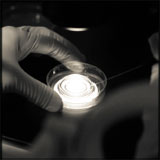Close
IVF
In vitro fertilization (IVF) is a therapy that is used for treating infertility, as well as some genetic disorders. The IVF procedure involves taking oocytes, or eggs, from the woman's body. Eggs and sperm are brought together in the laboratory (in vitro). Developing embryos are placed in the uterus, where pregnancy can occur.
Close
Down-Regulation
Mature oocytes must be retrieved from the ovary in order to perform an IVF cycle. Natural ovulation (release of eggs) is inhibited by the administration of one of two medications, Lupron or Ganirelix. These drugs act to inhibit the normal signal for ovulation. Lupron injections are given daily during the cycle prior to IVF treatment. Down-regulation is complete after 10-14 days of Lupron injections. In other cases, smaller doses of Lupron (Microdose Lupron) can be used just before and during the treatment cycle to prevent ovulation. Ganirelix is often used instead of Lurpon, and is given after stimulation of the ovary has begun.
Close
Ovarian Stimulation
Ordinarily, one mature follicle produces an egg each month. However, IVF patients are given injectable hormones, which stimulate the development of several mature oocytes. Follicle Stimulating Hormone (FSH) injections, such as Follistim, are given daily in the early stages of the IVF cycle. The MRM staff monitors each patient's response to these medications using vaginal ultrasound. This process allows the staff to better evaluate the development of the mature follicles. Estrogen levels are measured through blood samples. When the follicles are mature, the patient is given an injection to trigger the final phase of maturation. This trigger may be hCG (human chorionic gonadotropin) or Lupron. An egg retrieval is performed 35-37 hours later.
Close
Egg Retrieval
Egg retrieval is performed using needle aspiration in the MRM procedure room. An anesthesiologist provides the patient with light sedation using a combination of an intravenous injection of Versed and Fentanyl. A local anesthetic is also given. With the aid of a transvaginal ultrasound, the MRM staff evacuates individual mature follicles by placing a needle through the wall of the vagina and into the ovary. Our embryologist analyzes the follicular fluid in the laboratory to determine the presence of eggs.
Close
Insemination, Fertilization, ICSI, Embryo Culture
Once the egg retrieval is complete, the MRM staff determines which eggs are to undergo fertilization. The embryologist begins the process of fertilization using sperm provided by the patient's husband. In most cases, intracytoplasmic sperm injection (ICSI) is used to inject a single sperm into an egg.
ICSI is an effective treatment for men with very low sperm counts. For some cases in which there is no sperm in the husband's semen sample, sperm can be surgically retrieved from the testes and used with ICSI to achieve fertilization and pregnancy. ICSI is also an option for couples who are seeking treatment for infertility and have not responded to other treatments.
In some cases, standard insemination of the eggs is used for fertilization. The embryologist deposits some of the husband's sperm with the wife's eggs, which are then moved to an incubator.
The day after insemination by ICSI or traditional IVF, the eggs are examined with a microscope for indications of fertilization. If all goes well, 3-5 days after egg retrieval, healthy embryos that continue to grow are selected for embryo transfer.
Close
Laser Assisted Hatching
Another technique for aiding couples with complicated infertility is the use of a laser to help the embryo emerge from the surrounding membrane (zona pellucida).
Close
Embryo Transfer
The ultimate step in IVF is the transfer of the embryos into the uterine (endometrial) cavity. This procedure, performed in the MRM procedure room, does not require anesthesia. A narrow catheter containing the embryos is passed through the cervix and into the endometrial cavity under ultrasound guidance. The embryos are discharged into the endometrial cavity, and the catheter is removed. Normal activities may be continued the day after the transfer procedure. Patients take progesterone supplements after the embryo transfer to support the lining of the uterus. 10-12 days after the embryo transfer procedure, a pregnancy test is performed.
Close
Cryopreservation
Excess embryos generated during the IVF cycle can be frozen and stored. The embryos can be transferred to the uterus at a later time to achieve a pregnancy without the need for stimulation medications or invasive procedures.
Close
Using The Patient Portal
MRM offers an exceptional tool for patient care – the Patient Portal via our electronic medical record – eIVF. When you register as a new patient, you and your partner will be given a unique login and a temporary password. It is very important that you change your password and make it unique as well. With that done you will have access to all of the features of the Patient Portal, through the link from this web site.
Your first step as a new patient will be to fill out your own medical history on the Patient Portal. This must be done prior to your first visit with us. If you are unable to complete this entry prior to your visit, it can be done while at MRM, but that will lengthen your visit.
The Patient Portal allows you to view your upcoming appointments, any laboratory tests that have been resulted, any treatment calendars we may have for you (such as an IVF treatment calendar), and most importantly, provides an efficient method of communication with our staff. Through the correspondence function on the Patient Portal you can place a message to our staff anytime, day or night. Those messages will be reviewed on the next working day, and within 24 hours we should have an answer for you. You will need to login to see the response. This method of communication is much like email, is HIPPA compliant and secure, and avoids frustrating "phone tag". The portal is best used for single, specific questions that can be answered quickly. If you have multiple questions, need in depth answers to complex questions, or just want to talk, we suggest you do that at a regularly scheduled appointment. We look forward to taking care of you and helping you to recognize your goal of having/building a family.
Close
Other Considerations
Oocyte Donation
For patients who have poor egg quality or quantity (diminished ovarian reserve), we offer oocyte donation. The patient can provide known donors, or our anonymous donor list can be used. Anonymous egg donors are screened for genetic and infectious diseases. The pregnancy rate using oocyte donation is related to the age of the donor and is higher than the pregnancy rate for standard IVF.
Risks of IVF
There are uncommon but special complications associated with IVF. These include:
Ovarian Hyperstimulation Syndrome (OHSS)
This rare condition results in painful enlargement of the ovaries due to hormonal stimulation. Patients typically recover with bed rest at home, but hospitalization is sometimes needed. Procedures to remove excess fluid from the body are required in rare situations.
Egg Retrieval Procedure
There is a small risk of reaction to anesthesia, bleeding, infection, or injury to internal organs during the egg retrieval procedure.
When Pregnancy is a Problem:
Multiple Pregnancies
Approximately 25% of ongoing IVF pregnancies may result in twins (10% for MRM in 2012-2013). 5-7% of all pregnancies may be triplets (2% for MRM in 2012-2013). The risk of multiple births is decreased by limiting the number of embryos transferred based on age. When only two embryos are transferred, which is the norm, the twinning rate will be approximately 20% and triplet pregnancies will be rare.
Ectopic (Tubal) Pregnancy
A pregnancy that occurs outside of the uterine cavity occurs in 5% of IVF pregnancies.
Miscarriage
The loss of a clinically recognized pregnancy occurs in approximately 20% of all IVF pregnancies.
Financial Information
Mississippi Reproductive Medicine strives to provide the best possible care at the most effective cost. Costs are subject to change and specific financial information is available upon request.





